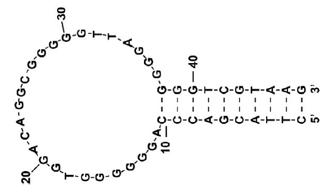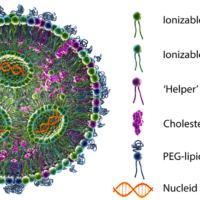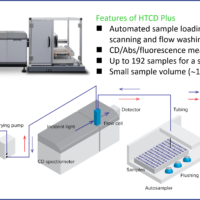Introduction
This article compares the accuracy of stability evaluations of a DNA sample using the temperature sensor inside a cell compared to the block sensor using UV/Vis spectrophotometer with peltier 8-position cell changer. The 8-position micro cell sensors as a temperature monitor (Figure 1), the horizontal axis of the temperature course data can be plotted with actual temperatures obtained by the sensor. This increases the temperature accuracy of small volume sample measurements with the 8-position micro cell.

Figure 1. 8-position micro cell sensors as a temperature monitor
For thermal melting studies, a temperature sensor can be inserted into a sample cell and the actual temperature of the samples plotted in order to increase the accuracy of the temperature readings for the melting experiment. This measurement technique is easily applied to 10 mm rectangular cells with larger sample volumes. However, for samples with small sample volumes (< 100 µL) a temperature sensor probe blocks the instrument’s optical path. It is then difficult to obtain both absorbance and temperature measurements of a sample simultaneously. By using one of the cells to monitor the sample temperature without obtaining absorbance measurements at that position, the melting temperature of the sample solution can be accurately recorded.
Additionally, when performing a melting measurement on samples available in extremely small amounts, volatilization of the sample can occur at high temperatures, frequently complicating the analysis process. Placing a silicon cap on the cell can prevent sample volatilization.
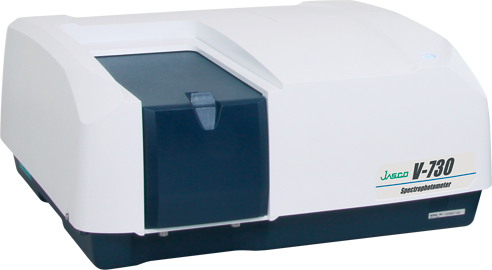
V-730 UV/Vis spectrophotometer
Experimental
A 20 µg/mL solution of poly (dA-dT)-poly (dA-dT) was made in KH2PO4-NaOH buffer at pH 7. Samples were measured in cells 1-7 while cell 8 was used only to monitor the sample temperature.
Measurement Conditions
Wavelength: 260 nm
Response: Fast
Ramp Rate: 2 °C/min.
Start Condition: ±0.01 ºC for 3 seconds
Data Interval: 1 ºC (20 to 50 ºC), 0.1 ºC (50 to 70 ºC), 1 ºC (70 to 100 ºC)
Keywords
UV-Visible/NIR, Biochemistry, water-cooled Peltier cell changer, Temperature Control Measurement, DNA Thermal Melting
Results
The melting curves from the results of sample measurements with seven micro cells using the internal cell sensor are plotted as shown in Figure 3. The horizontal axis of the graph indicates the values of the temperature monitor sensor in cell 8. The sample measurement required a total of 5 hours; 2.5 hours for heating and 2.5 hours for cooling.
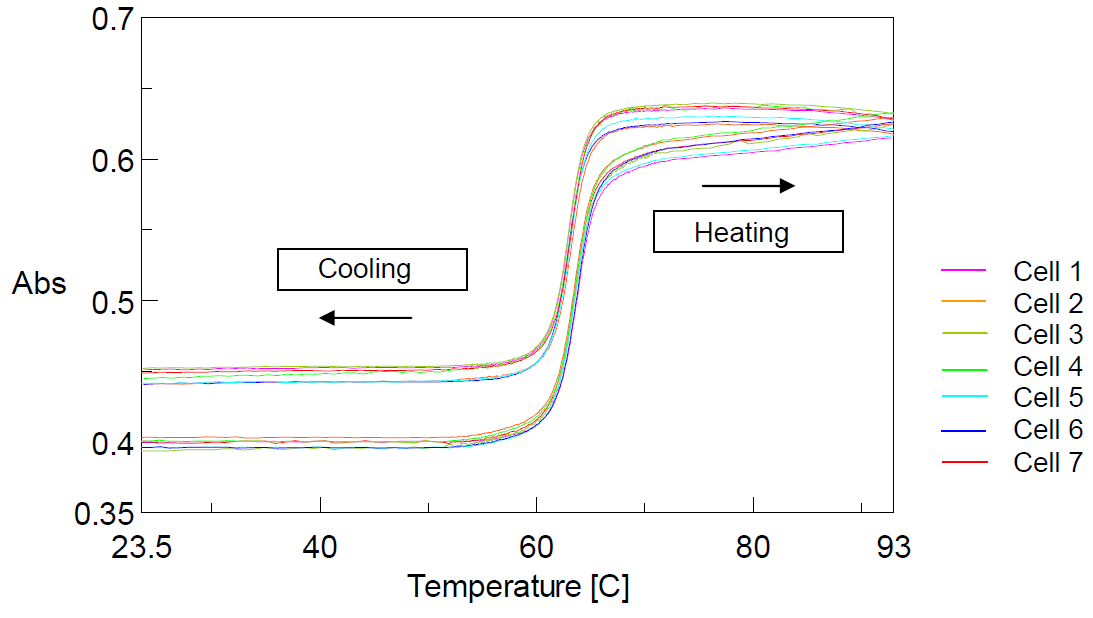
Figure 1. Melting curve of poly (dA-dT)-Poly (dA-dT)
Table 1 shows the melting temperature calculated from the temperature course data outlined in Figure 3. Melting temperatures at heating condition were from 63.4 to 63.6ºC (Ave. of 63.5 ºC), and a standard deviation and a coefficient of variance was 0.10 ºC, 0.15 % respectively. Melting temperatures at cooling condition was from 63.1 to 63.3 ºC (Ave. of 63.1ºC), and a standard deviation and a coefficient of variance was 0.08 ºC, 0.12% respectively.
Table 1. Melting temperature (Internal cell sensor)
| Temperature °C | ||
| Heating | Cooling | |
| Cell 1 | 63.6 | 63.2 |
| Cell 2 | 63.4 | 63.1 |
| Cell 3 | 63.4 | 63.1 |
| Cell 4 | 63.4 | 63.1 |
| Cell 5 | 63.4 | 63.1 |
| Cell 6 | 63.4 | 63.1 |
| Cell 7 | 63.6 | 63.3 |
| Average | 63.5 | 63.1 |
| Standard Deviation | 0.10 | 0.08 |
| C.V. | 0.15 | 0.12 |
The same measurement was performed while obtaining sample temperatures using the standard temperature sensor (the holder sensor). Table 2 shows the melting temperatures calculated from the temperature data using the holder sensor. Melting temperatures were from 66.4 to 66.7 ˚C (Ave. of 66.5 ºC).
Table 2. Melting temperature (Holder sensor)
| Temperature °C | |
| Cell 1 | 66.6 |
| Cell 2 | 66.4 |
| Cell 3 | 66.4 |
| Cell 4 | 66.4 |
| Cell 5 | 66.4 |
| Cell 6 | 66.4 |
| Cell 7 | 66.7 |
| Cell 8 | 66.5 |
| Average | 66.5 |
| Standard Deviation | 0.12 |
| C.V. | 0.18 |
Conclusion
The data show that the melting temperature using the holder sensor was approximately 3 ºC higher than using the internal cell sensor, while both the standard deviation and coefficient of variance had no major differences in their result. These results indicate that the holder sensor can sufficiently measure a reproducible melting temperature for all sample cells. However, to obtain the absolute temperature value for sample melts, a cell temperature sensor is highly recommended.

